Clay is widely distributed in nature, it lies in shallow depths, serves as a cheap kind of mineral raw materials in many types of industry, is used in the national economy. It is also used in art. With its help, when creating a sculpture, mock-ups are made. Tools for molding from clay in the first place should be easy to use and fully meet the requirements for processing this plastic and pliable material.
Application
In the old days, masters made krynki, pots, jugs and other items of kitchen utensils from special types of clay. After firing, such utensils remained in shape, did not let water pass, and was quite strong.
The most suitable types of clay for modeling are plastic varieties of gray, gray-green and green varieties. They are used in modeling and sculpting. Masters initially make of this material volumetric models with the subsequent casting in gypsum or bronze.
If the clay sculpture is exposed to roasting, then this work is called terracotta, and if it is additionally covered with glaze, it will already be majolica.
Varieties
Refractory clays withstand firing without softening the temperature above 1500 degrees. They are used in the production of acid-resistant porcelain and faience products and in the manufacture of molds for metallurgical casting.

Light-melting grades are used in and in the process of producing portland cement. Bentonite types of clay for modeling are the least suitable. They are used for cleaning oil products, vegetable and lubricating oils, as well as drilling wells.
Polymer clay
Artificially created material, based on polyvinyl chloride with the addition of plasticizers, pigments and fillers, is called thermoplastic.
The material is externally and similar in properties to plasticine in the process of molding, but it spoils hands less, does not spread from the excess heat of the palms. Some tools for modeling of clay of this type are used only in this kind of applied art. For example, to roll out layers and mix different shades of material, a special paste machine is used.
Produced by different manufacturers and is divided by the method of hardening into two types:
- Self-curing.
- Baking (thermoplastic).
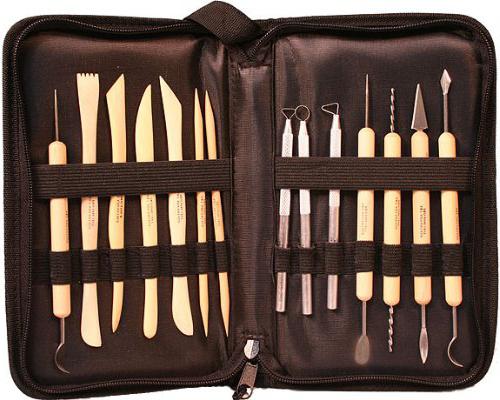
Self-curing polymeric clay
A characteristic feature of this material is that after molding it collects strength at room temperature per day without additional heat treatment. Self-curing polymeric clay (plastic) after drying has a sufficient strength, holds the mold well, is processed, if it is necessary to correct some details. The surface is then soaked in water, after which the necessary adjustments are made.
This kind of polymer clay is ideal in the process of creating dolls, especially elements of their clothes and accessories. Another important direction of its application is the creation of floral compositions. Thin leaves, and especially the petals of flowers with thinned edges to the minimum, look like living after giving the product a characteristic texture surface.
The minimum required for modeling is to include a rolling pin so that the layers can be rolled out and easy to cut from the thin layers of the composition details. The devices for imprinting shapes and extruding textural elements can also be useful. When working with small parts it is convenient to use stacks.
Baked polymer clay
Such material, when heated to a temperature of 110-130 degrees, acquires the properties of plastic. Finished products are not afraid of moisture, they can be bent without fear of breaking.
Working with thermoplastic is convenient. It is a soft material, plastic, well mixed. After heat treatment, the surface becomes velvety. A set of tools for molding from thermoplastic is the same as for self-hardening clay. The material for making dolls, souvenirs, small sculptures, flower compositions, all kinds of costume jewelry is used.

Some manufacturers produce two types of thermoplastic: one - soft, which is more suitable for children's creativity; the other is a more rigid material, requiring thorough kneading before modeling, but also featuring increased strength of the finished product.
Molding from polymer clay: tools and materials
The working surface is selected from ceramics or glass. To roll out the raw material into the strata use a rolling pin, rollers or a special paste machine. The extruder with interchangeable nozzles is squeezed out simple or figured "sausages".
To give the surface of a special kind of use stamps, textural sheets and brushes. Materials and tools for modeling are selected individually by each master. Molds are needed for repetition molding. Stacks with different profiles are indispensable when modeling small parts. Needles are used to make holes.
In some cases, foil can be useful for creating a lightweight frame and saving material. Sandpaper can grind finished products after heat treatment. Keeps the material well from drying.
Need and auxiliary tools for modeling of clay. Pliers, round pliers and pliers are indispensable when working with wire to create fittings for future products. For cutting formed formations fit stationery cutters and sharp scissors.

Homemade devices and forms
The necessary tools for modeling by themselves can be made by anyone. In some cases, you do not even need to do anything, you can simply adapt a shape suitable for molding, molding, extruding, or figuring.
So, the kitchen noodle can be used to create even strips from the rolled out layer. Press for garlic can squeeze out thin threads. The heads of screws with grooves for a figured screwdriver can create decorative elements on the surface. It is convenient to make a grid in the form of a grid. You can use to extrude a piece of pumice, the effect of "salt texture" can be achieved using a hard toothbrush.
Suitable tools for modeling from clay are everywhere, you just need to notice them. caps from bottles, figured buttons - everything can be used for forming, extruding or stamping. For rolling the material, you can use a simple glass bottle, and instead of a stack for fine work, you can take a toothpick.
Before you start, you should take care of protecting the surface of the table, where you plan to take up creative work. Separating a piece of plastic, it should be slightly stretched in the hands, so that it warmed up and acquired the necessary softness.
To get acquainted with the material, get the first skills of working with a new kind of raw materials, and also learn tools, for modeling from clay it is better to choose a simple model. Roll out a mashed piece of plastic on the work surface, you can try to cut something out of it, give the workpiece a different texture with the help of molds, stencils or special textural sheets.

You can sculpt a small sculpture, try to make a simple composition in the form of a flower or other three-dimensional shape. The first test lesson should be brought to its logical conclusion. Self-curing clay is simply dried, and thermoplastic should be baked.
For this, the product is laid out on foil, parchment, ceramic tile or a plate and placed in a preheated oven to 110 degrees for the baking time indicated in the clay instructions. After heat treatment, the model cools in the oven, is extracted, painted and varnished.
What is the name of modeling of clay?
Enterprising people with creative potential can easily realize their talents with practical benefits, manufacturing and selling original beads, earrings, bracelets, as well as various souvenirs and various pleasant trifles. The name of this type of creativity is determined by the technique of execution of the finished product.
The existing techniques of molding from polymer clay are so diverse that they enable the newcomer to choose his occupation for any level of complexity. The name of this or that kind of modeling is determined by the methods and methods used in the manufacture of decorative elements. For a simple flower or simple sculpture one technology is used, multi-layer filigree or millifiori in the creation of author's ornaments - quite another specificity of the work.

Techniques of working with polymer clay
How many good masters, how many unique products, so much and the technique exists at the moment. Some are very popular and can be taken as a basis for beginners.
The technique of "watercolor" involves the use of contrasting layers of colored plastic, rolled in a paste machine. In the "color transition" - on the contrary, smooth and fuzzy boundaries are used.
The "bargello" technique imitates Florentine embroidery, "mica shift" creates volume effects on a flat surface. The technique "mokume-gene" borrowed from Japanese gunsmiths combines the texture of wood and metal, and "imitation" creates a kind of natural minerals, natural and precious stones.
"Filigree" and "millifiori" - techniques for drawing up a complex drawing of thin layers, filaments or balls. This occurs in the process of grimacing, drawing and rolling on the surface of a thin section of a complex composition.
Surprising beauties are obtained as a result of the application of techniques: "kaleidoscope", "multilayered", "through", "salt", "syringe", "brain", "image translation".
In addition to the listed species? there is still a puppet, sculptural and floral technology. They, in turn, have their own peculiarities and varieties of molding and forming techniques, the fineness of the assembly of composite elements. Tools for modeling from clay for each specific case are selected by the master individually.
In fact, the kit consists of 6 different stacks for working with polymer clay. Made of stainless steel, the central part is like wrapped in an insulating tape, while holding in your hand and working with them conveniently. For details and examples of work with the use of separate stacks, please cut.
Working with polymer clay is my recent hobby, he still has not a year, but time and space it takes more and more. By buying the subject was a long time, in the end I do not regret anything, although I actively use only 2 stacks of 6.
First of all about the price and why the choice fell on this set.
This seller this summer I bought a set of acrylic rolling pin, there was a small scratch on the big rolling-pin, also did not please the poorly worked ends (). As compensation for moral damage, the seller kindly offered me a discount for the next purchase. Completely exploring the assortment of goods store my choice I stopped on a bright set of stacks. At the first viewing and choosing the goods on it was a discount of 50% when ripe to purchase. the rebates were no longer there. I had to be patient and wait for the August sale. As a result, at the time of purchase, the price was 758 rubles. (who remembers that day, probably remembered and the jump in the rate) after presenting the promised discount, we had to pay only 400 rubles. What was very happy in comparison with the starting price.
The order was sent within three days, the delivery was 3 weeks, the track was tracked.
The instrument came in a bubble package, without damage. Odor at the opening of the package did not publish.
Packing photo: 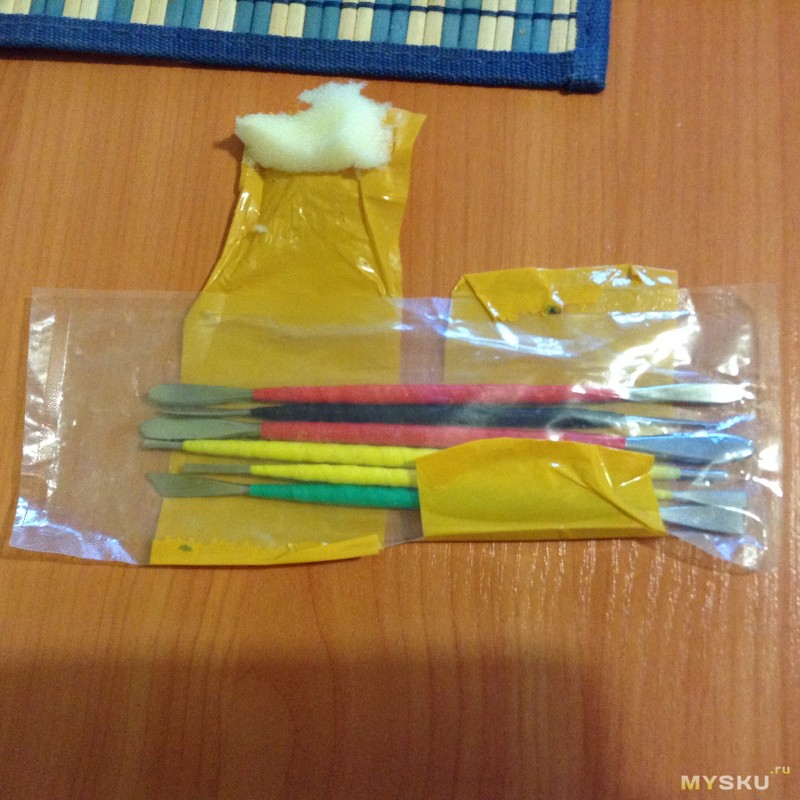
But the current photo of the instrument 
The purchase of the tool was the impetus for the systematization of all devices for working with plastic, a pen-machine was bought in the fix price (the size turned out to be ideal for a roll) and a couple of capacious containers for molds, boats, polymer clay bars. This is how my workspace looks now: 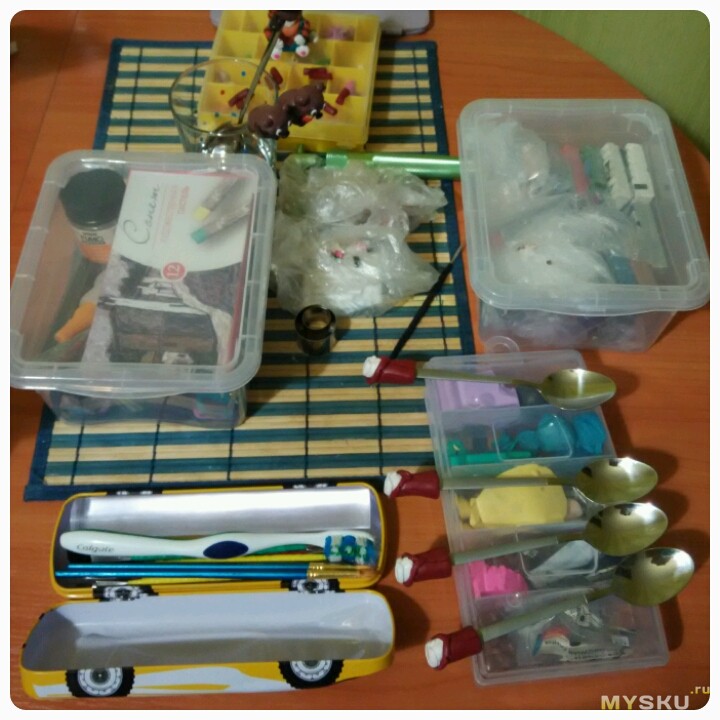
Learn more about the instrument itself.
The material is stated as stainless steel, magnetized, but weakly. In the hand is very comfortable. Due to the small size and weight is great for working with small figures, details.
The sphere of my work with polymer clay is quite satisfied, I make figurines for the most part of cartoons for decorating cutlery. Perhaps that's why I actively use only 2 stacks.
The grip zone by hand, as I said, looks like it's just wrapped in electrical tape. For a month and a half, the regions began to podissatsya. Of the advantages of such processing - it is easy to update, here and the color itself can be chosen at will and the thickness of the winding.
Each stack has two working parts, which is very convenient, but, unfortunately, the potential is only used half. In three stacks of six, the two working parts are the same in shape and size. Number 1 and 2 just shout about the need to combine them into one tool.
The stack length is about 15-16 cm. 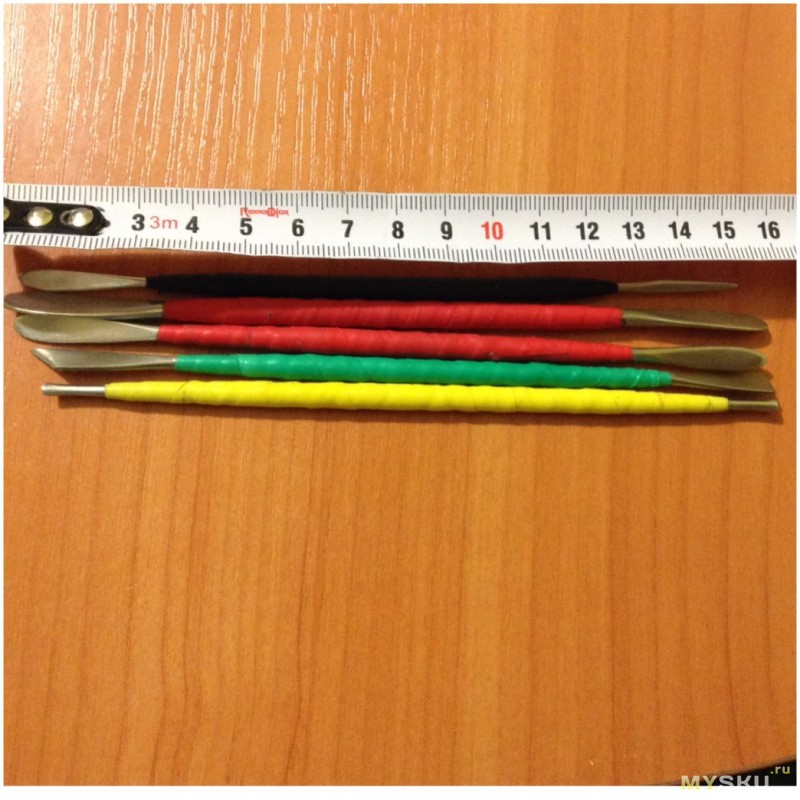
We will consider each separately.
Number 1. Shoulder. The first of the most necessary. 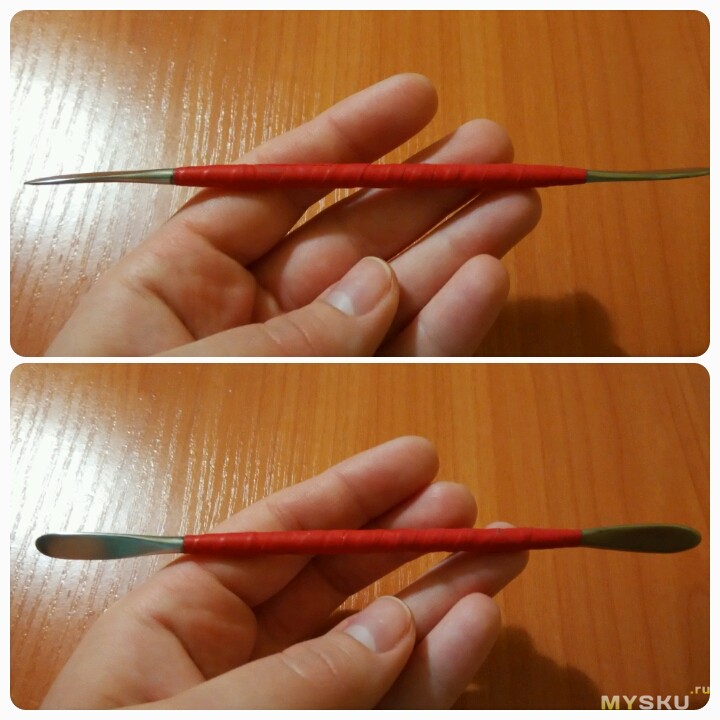
The shape and size of the blade are the same on both sides of the stack. It would be even better if on one side the shoulder blade was larger, and on the other hand smaller. Why do we need a spatula? The most important thing in it is help in uniting the individual parts into one whole. It is better to show 1 time than 10 to tell: 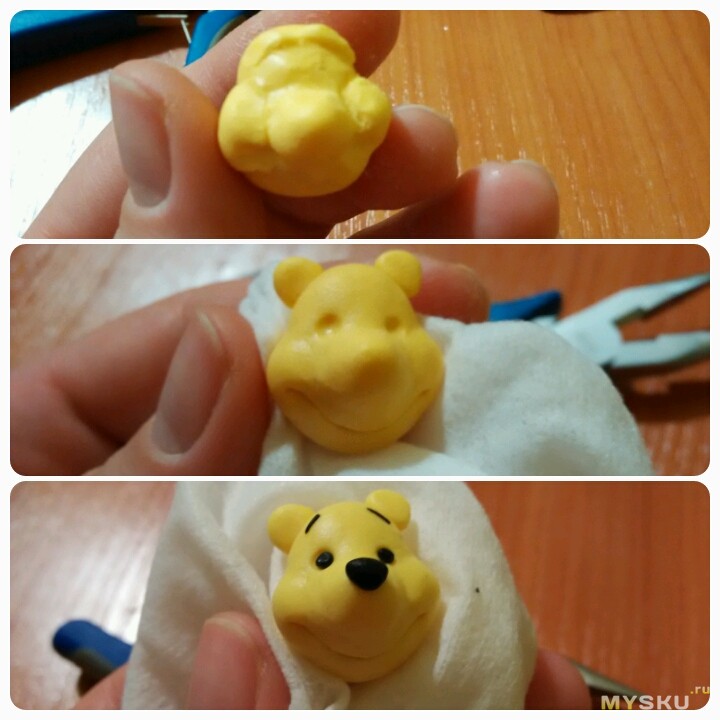
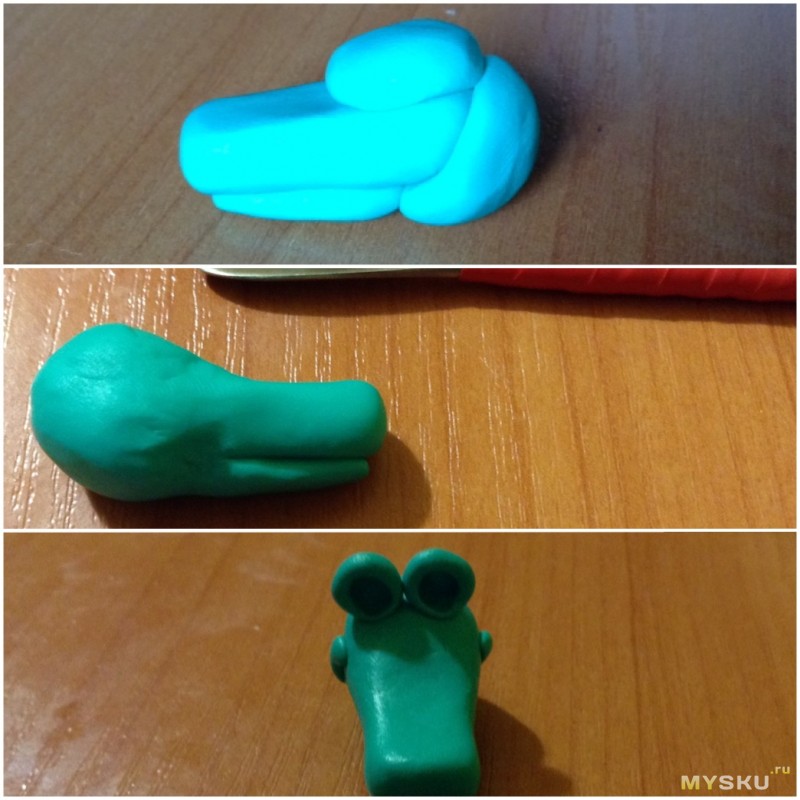
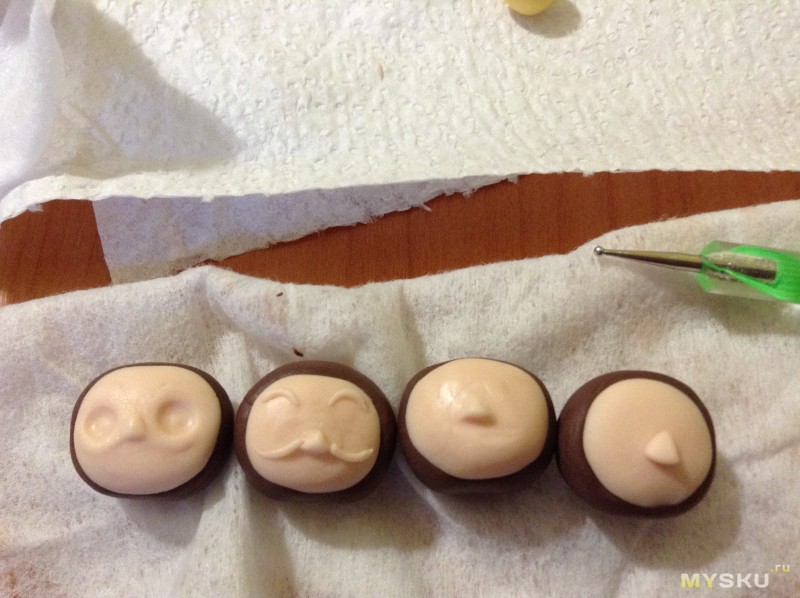
It is clear from the illustrations that to create a relief of the face it is necessary to take the base (roll the ball, give it the desired shape) and sculpt all the convex parts, cheeks, nose, eyes, mouth, looking at what it stands for :) Then all the joints need to be ironed so that the detail looked harmonious. This is not as simple as it may seem, plasticity of the material in this case plus and minus simultaneously, it's worth to pass a little and on the spot of the convex part there will be a pit. That's why it's uncomfortable to work with a finger, the stack is easier to adjust the force of pressing, since its surface works well and is viewed in the plane.
The second important function stems from the first - the final grinding of the product, I mean the removal of fingerprints. There will be no prints if you work with gloves, but not all small parts can be glued in gloves. 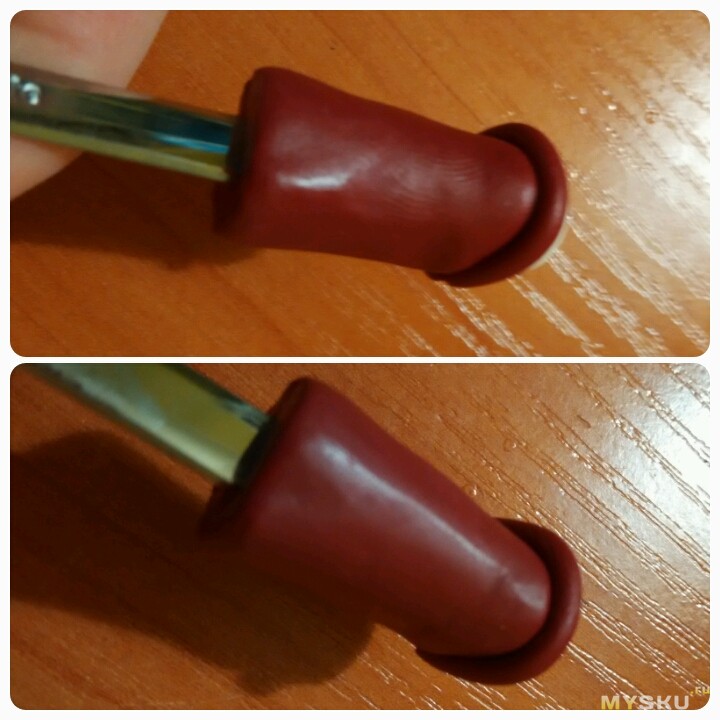
Number 2. Again the scapula, slightly less than number 1 in thickness and width. 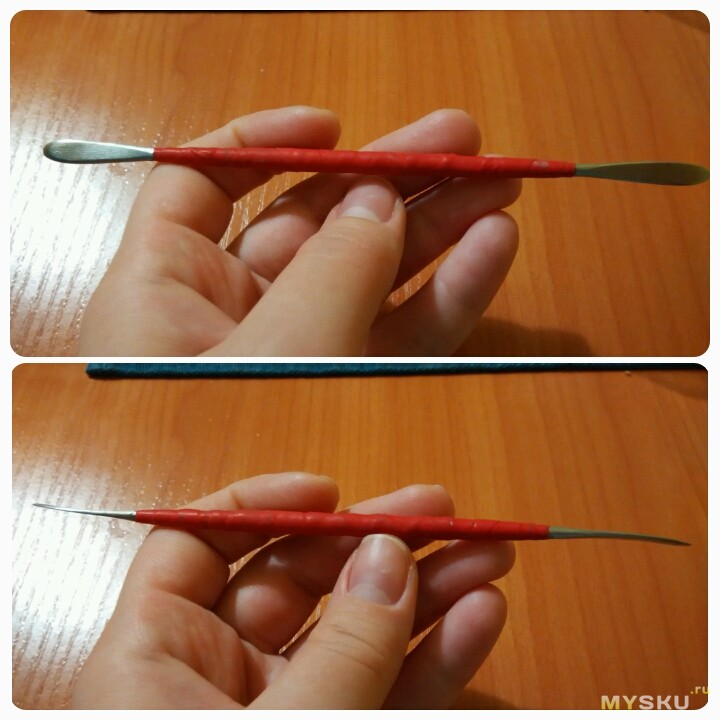
The functional is the same. I use one or the other, which will fall under my arm.
Number 3. The cutter is narrow, on the one hand the blade is straight, on the other hand it is at an angle. 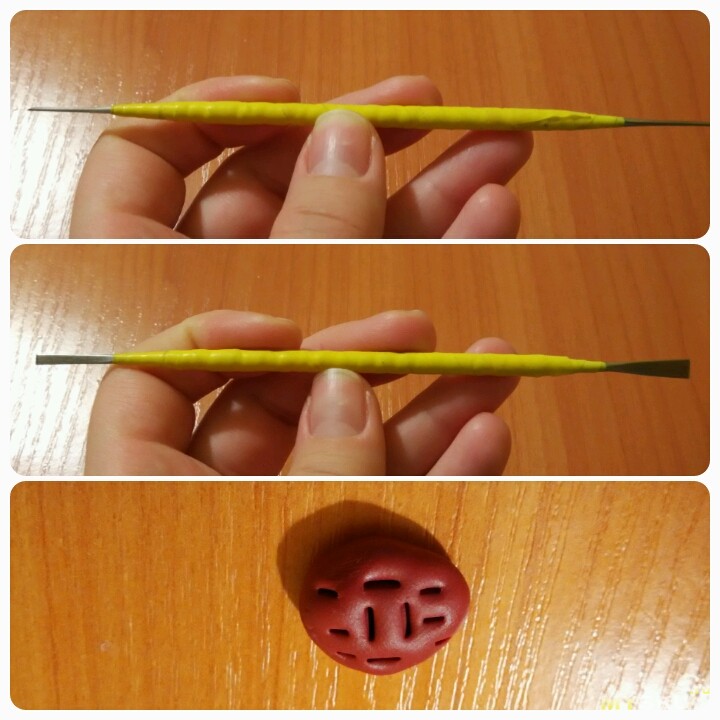
The blade is double-edged, but the sharpening is not such as to cut something, except for polymer clay or other material similar in plasticity. Its task is to leave a clear trace on the polymer clay, with which it copes.
The fingers do not cut. I rarely use it, basically if I need to pick out a smooth piece.
Number 4. The cutter is wide. As in the case of number 3, one side is flat, the second is sharpened at an angle. 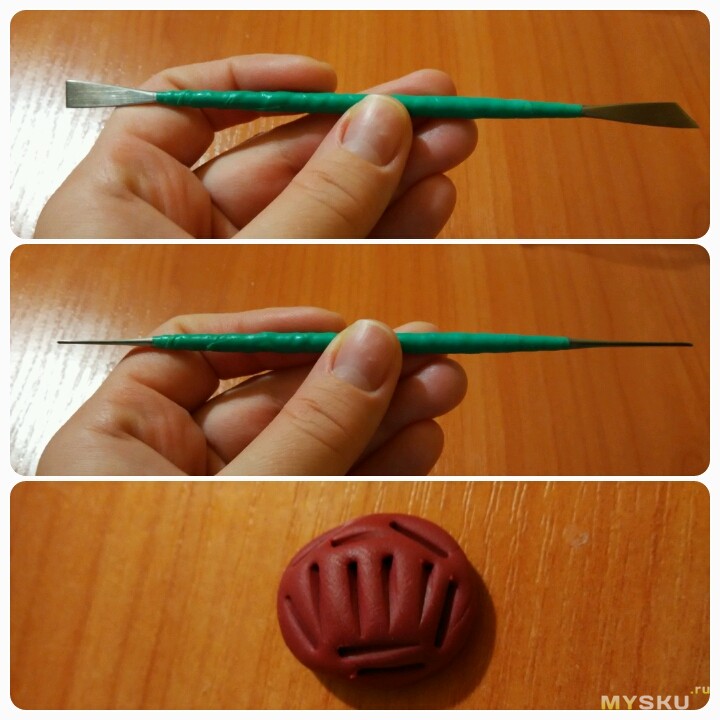
The functions are the same as the sharpness of the sharpening. I use even less often, I prefer a sharp sharpening knife.
I tried recently to make an imitation of the bear's fur with this stack, nonsense came out, and the clerical knife gave the following result: 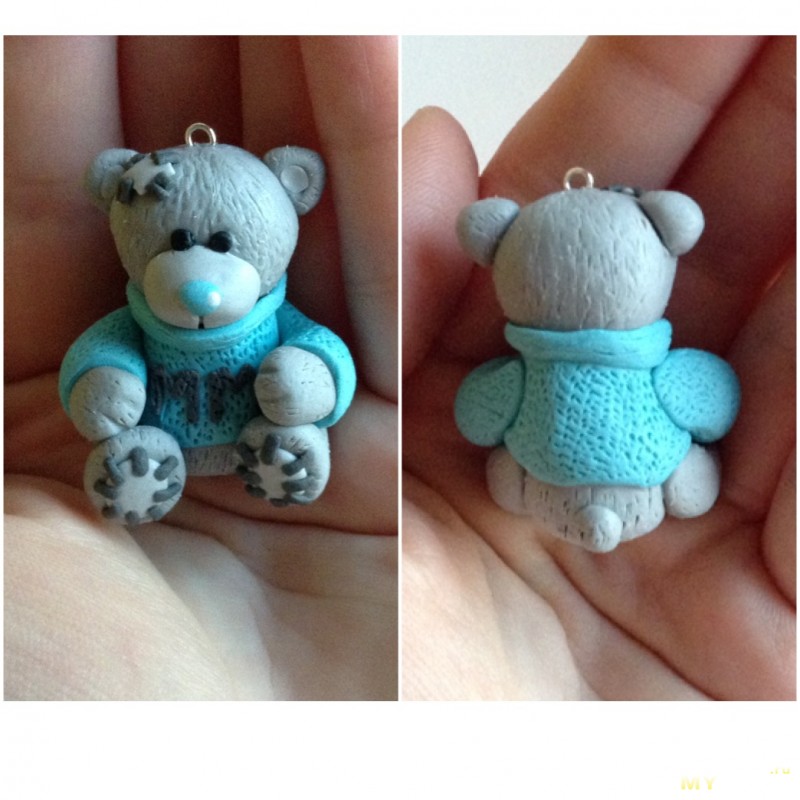
The result of the stack has not been preserved, but take a word, it turned out to be complete nonsense, because the incisions are thick and not deep enough to imitate the wool on a small area of the bears.
Number 5. Blade and skewer (names are inspired solely by my associations, I did not find the information in the description of the goods). The most commonly used stack. The blade differs from the numbers 1 and 2 in even finer dimensions and sharpened on one side, which allows it to cut the material well, if necessary. Shpazhka simply an indispensable thing to describe the mouth, the smell of a coat and so on. On the photos of Winnie the Pooh's head, the crocodile Genes, and in the final products, almost everywhere the mouths are work by stack number 5. 
Number 6. Hoof. Used for setting points, for example, for the eyes. But I use a manicure dots for this purpose, so the hoof lies idle. 
That's all. The tool is not really a prerequisite for working with polymer clay, you can do with a knife and toothpick, but it takes the process to another level. You feel like a surgeon: "Assistant, scalpel, clamp, tampon, still a tampon"!
And in the end, what finished works look like: 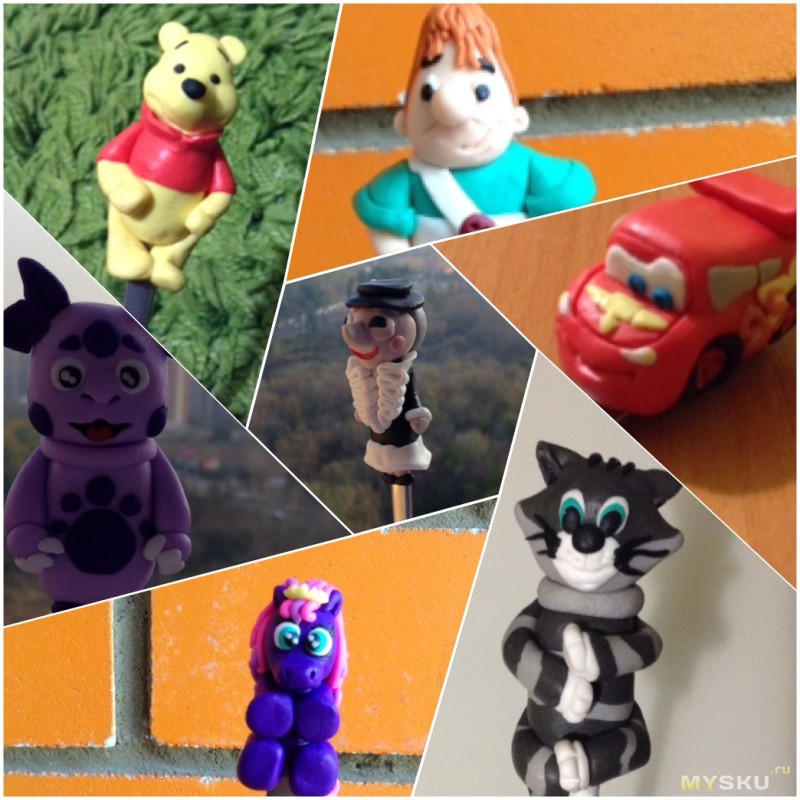
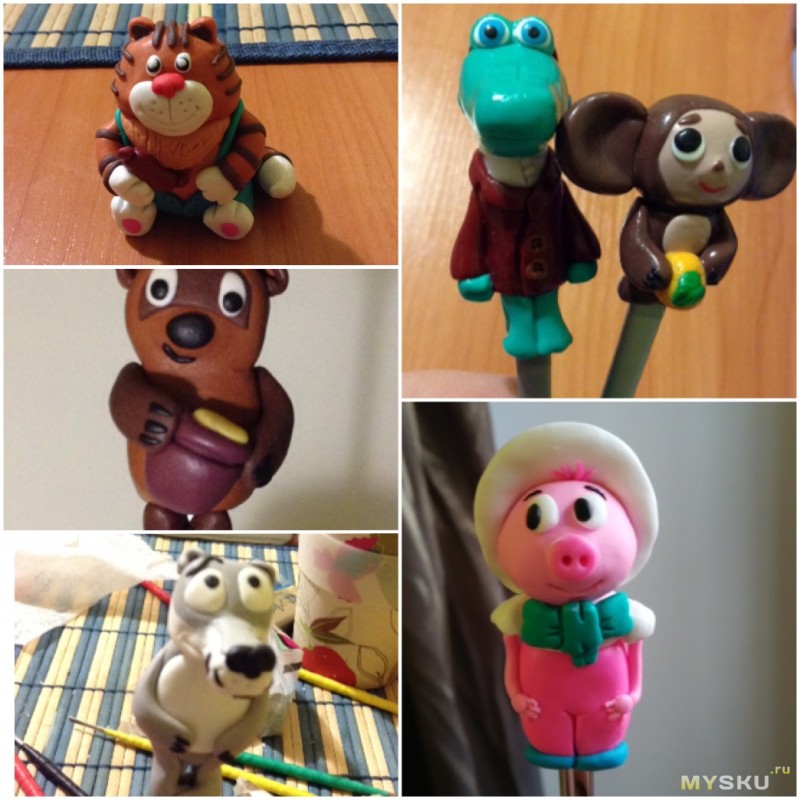
All the good time of the day :)
I am glad to welcome you, Friends!
In the Internet you can find a lot of cognitive information about tools for convenient work with polymer clay, I once again decided not to repeat. And I'll write about my personal preferences. Today my story will be about some of my basic tools that help me when working with baked polymer clay. In the process of work each master creates for himself the necessary list of tools. You can always pick up more or less expensive analogues.
As I said before, I give preference to the clay of "Fimo", "Sernit", sometimes "Sculpey Premo".
The set of my tools depends on what kind of product I want to make from plastic.
So, let's start:
1) My working surface.
It consists of a mat for polymer clay, it is made of non-slip silicone, which prevents the adhesion of clay to the working surface. The mat is fireproof and allows me to bake all the clay crafts directly on it. Sometimes I use a mate for modeling MAKIN'S, green, 35 * 35cm-it's dense, good for work, but it's not good for baking.
Some masters use wooden tables or woodwork as a working surface. In my opinion, they are not convenient for work, because absorb polymeric clay and are not always perfectly even. Ideal for work: a piece of glass, ceramic tile or other smooth surface, to which plastic will not stick during work, they can also be baked.


2) Blades, knives.
I have a set of 4 blades with comfortable grip holders.
Stamps: "Sculpey". Special blades for polymer clay allow you to cut off even pieces, cut out the necessary curly elements. But you can use a stationery knife for cutting.

3) Cutters and molds for carving. They exist in different sizes and shapes - square, rectangular, round, oval, curly. Basically I use a set of mini-forms for clay, it includes 12 different shapes that allow you to create unique ornaments, applications.
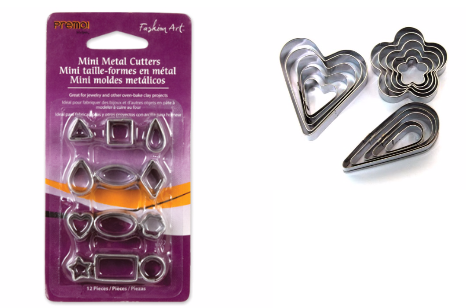
4) Roller for rolling polymer clay.
For rolling, an acrylic rolling-pin is suitable, they come in different brands. You can replace the rolling pin with a glass bottle, the main thing is that it should be flat, with a smooth surface, i.e. without seams.
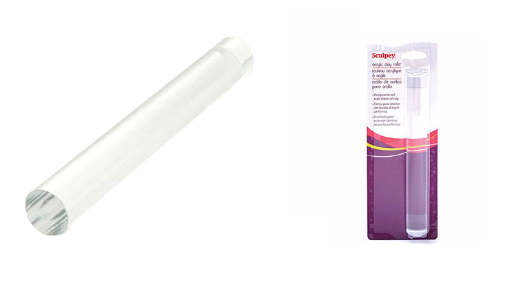
5) Paste the machine. At me-Fimo, it greatly facilitates the process of working with polymer clay, allows you to choose the thickness of rolled sheets of plastic, and without too much effort to make the transition of color, is very useful when creating products in certain techniques.

6) Extruder - is a syringe, by which the polymer clay is extruded, giving it the desired shape. The shape of the extruded clay depends on the nozzle used. Just like the pasta machine, it helps to create interesting color effects. The kit can include up to 20 different attachments for making sausages of different shapes. Extruders produce the company Sculpey, Makin's.
I have a Fimo brand extruder for polymer clay with a handle of a special shape, for easier handling it is easy to scroll with minimal load.
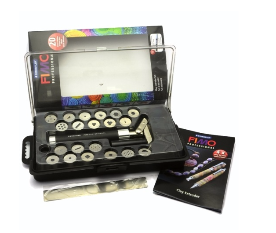
7) Needles, toothpicks, sewed. Needles and awl I use for piercing beads, also for giving different textures to clay. Toothpicks are the main tool, because they are very convenient to bake beads, it is only necessary to insert them into the slide from the foil, you can bake.

8) Stacks. They are not an obligatory tool, but they help a lot when working with small details in modeling. They come in different shapes and with different attachments. They are sold in art stores.
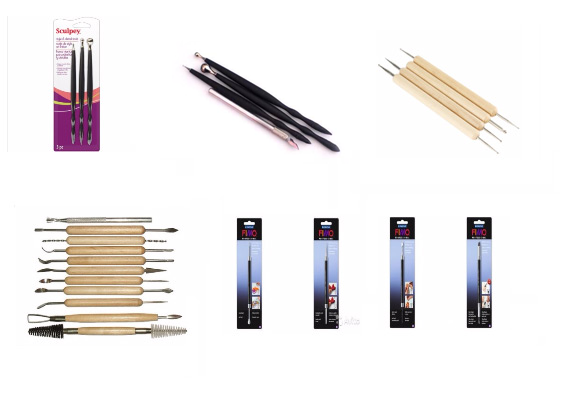
9) Textural sheets, stamps. This is not an obligatory tool, I use them very little. The use of texture sheets requires certain skills: the polymer clay must be rolled using an acrylic roller or paste machine in the required thickness sheet, then the texture itself should be rolled to the plastic.

10 Molds.
Molds are also made of flexible silicone or plastic, only deeper. They are designed to repeat elements. In form they are diverse and in the end after using the mold you can get the finished product. Mold can be bought at any art shop or manufactured by yourself.

11) Food film. This is an essential element in the work with polymer clay. It is needed to store clay.

12) Wet and dry napkins. Very useful in the work, because from some colors of clay hands get dirty, and when working with white plastic is an irreplaceable thing.

13) Medical gloves. I always work in gloves to avoid leaving fingerprints on the product.

14) Sandpaper, nail file. Help remove all roughness and roughness on the finished product. Usually used after baking. Usually, I grind the wet sanding sheet, so the dust flies less from the production.
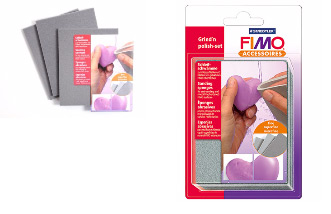
15) Oven for baking.
I have a Scarlet SC -099 minigarch (black) with a temperature regulator, but to be honest, it never helped me, because I never leave the baked goods on my own, always sit next to and watch the temperature. Agree it is a pity, when, having worked all day, then everything is spoiled.

16) Thermometer.
It's just an irreplaceable thing if your oven does not have a precise temperature determination. When baking clay, you must always observe a certain temperature. Without it, you should not even bake anything! Failure is assured - either everything will burn, or it will not be baked. I use the brand "Fimo", very satisfied, but you can buy any, just to show the temperature correctly.
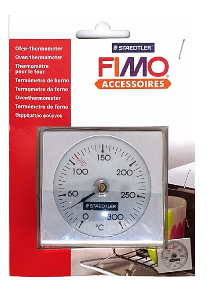
17) Tools for the assembly of jewelry. I have a set of Mikron, very comfortable, in a case.
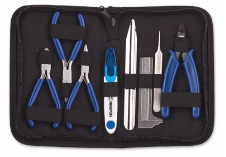
1. The pliers have flat lips. They can be flat and grooved. More commonly used for breaking links, rings, as well as for holding small parts.
2. Pliers with elongated bent ends - for work in hard-to-reach places, as are convenient for installation of locks.
3. Combined pliers with built-in cutters, etc.
4. Nippers are a cutting tool. They are used for biting wire, string, fishing line.
5. Round nose pliers are used to work with pins and wire. Thanks to them, you can make a ring at the end of the pin.
18) A machine for drilling beads and other plastic products. Used drills 1mm; 1,5mm, 2mm. They are sold in the building store.
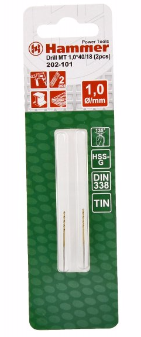
19) Varnish for polymer clay. My favorite Fimo and Scalpie. Varnishes can be matte or glossy. They cover already finished product, for protection from the external environment or simply for shine. I use acrylic varnishes on a water basis - these are special varnishes for polymer clay.

Please remember which varnishes are not suitable for polymer clay:
-Normal varnishes for nails - they have a completely different formula and they can start to stick through after a while.
- Varnishes for hair - they are not waterproof, in addition, they like to settle dust.
- Acrylic varnishes for needlework and universal, which are sold in stationery and handicraft shops - they often do not dry on plastic. A typical example is "Hobby-Line", "Sonnet". I will write a detailed article about lacquers later.
20) Synthetic brushes for applying varnish. Also useful for acrylic paints.

21) Adaptation-Ruler for easy mixing FIMO in an unlimited number of shades. Made of flexible translucent plastic, contains a ruler and templates. Useful thing. 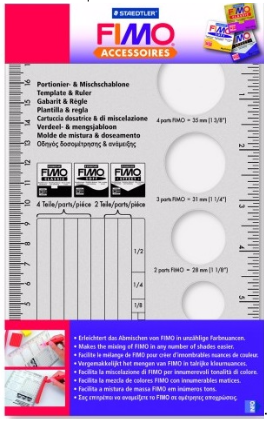
22) Roller for beads of "FIMO" brand. A useful thing, especially when you need to make a lot of the same size and shape of beads. Beads are created in different sizes and shapes. But you can do with your hands))

23) Softener for plastics. Is on sale such a liquid-plasticizer, which helps to soften the dried piece of polymer clay, it is sold in small containers in stores for needlework. Fimo and Cernit, for example, she-in pieces. Scalpie - liquid in a jar, I prefer in a liquid form. Overdried polymer clay should be mixed with a small amount of plasticizer, and it will regain its lost properties. Especially note that add plasticizer to soften it in small portions.

24) Liquid gel for gluing or as it is called liquid polymer clay.
I use Fimo Liquid Deko Gel. It is baked at a temperature of 130 ° C (note the packaging, some should be baked at 110 ° C!) For 20-30 minutes. FIMO gel is the most transparent, homogeneous and stable in the baking process, and this is a very important indicator for me. (Data based on tests performed compared to other brands)
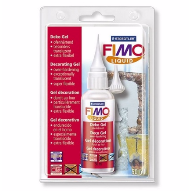
25) Paper for baking and foil. Baking paper is useful as a substrate for baking products, and the foil will serve as an excellent base - the hill is also for baking - pins and toothpicks with beads or other products such as berries or flowers are well placed in it.

26) Acrylic paints and a set of dry pastels for giving naturalness, for example leaves, flowers, berries.
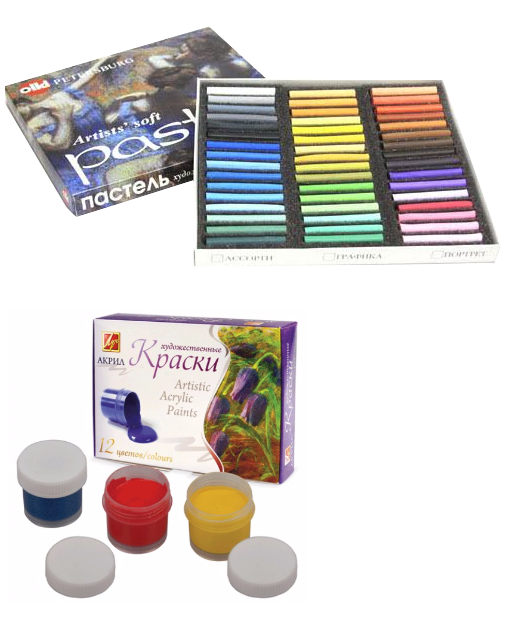
27) Accessories and beads.
If you are going to make jewelry, then you just need the accessories and beads!

I hope you liked my article! I wish you creative success and inexhaustible inspiration!
You can leave your questions under the heading "QUESTIONS AND ANSWERS", I will definitely answer you!
Attention! Dear friends, if you liked the article and you decide to copy it, or post it on other sites (pages in social networks), please indicate the author and give me a link to my site. Thank you for understanding!
In this article you will find a complete list of tools for working with polymer clay. I am often asked which plastic tools are needed, so I decided to write a detailed article on this topic.
Immediately I will say that in addition to the basic tools for polymer clay, which are used by all masters, there are many additional and less popular devices. "Individual" set of favorite instruments with time each master forms for himself.
I'll tell in this article about the tools that every master working with polymer clay should have in his arsenal.
1. Working surface (substrate for work so as not to smear the table)
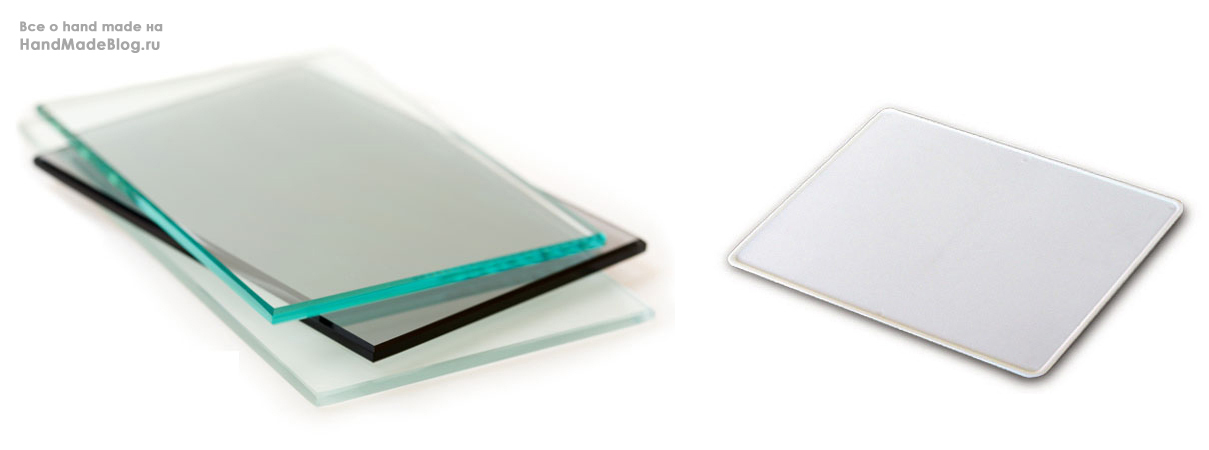
The main requirement is maximum smoothness of the surface, as well as resistance to cuts of knives, since clay particles are clogged in such pares, and they smear new pieces of plastic. The substrate for work should not slide on the table, for this under it you can put a non-slip material or attach it to the table with small pieces of double-sided adhesive tape.
As a working surface suitable:
- Planks for modeling (quality and very smooth)
- Tile
- Glass
- Pure paper
It is undesirable to use wooden surfaces - they quickly scratch and absorb the particles of plastic.
2. Blades
When working with plastic, you can not do without cutting objects:
Stationery knives are great for this purpose. With their help, you can cut, divide the plastic into parts, cut out the necessary elements from the plastic. Blades for stationery knives can be bought in any stationery or kiosk "Rospechat".

Professional blades are produced by plastic manufacturers. Traditionally, the kit includes rigid, flexible and wavy blades. Good blades make it possible not to lubricate the pattern when cutting, to cut the sausages clearly and evenly, and thanks to the flexible blade, you can carefully cut out unusual curly details.

3. Roller for rolling clay.
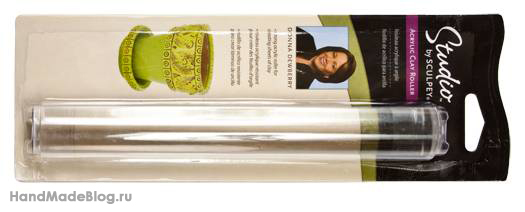
The best option - a transparent acrylic rolling pin (they are produced by well-known brands Studio by Sculpey, Makin's, Fimo). Also on sale there is an acrylic roller (roller) - the same rolling pin, only with a handle.
At first you can do with improvised means. The rolling pin can be replaced with a glass bottle or a plastic or metal tube. The main requirements for such a "replacement" - a smooth cylindrical shape, stiffness, smooth surface and lack of seams.
4. The paste machine will help you:
roll the polymer clay into smooth layers of the thickness you set, create a smooth transition of color - a mixture of Skinner, make a textured surface on plastic, prepare plastic for the technique of mika-shift.

5. Extruder (a tool similar to a syringe) serves to extrude clay through one or more holes in the nozzle. It helps to save masters time and get interesting color effects.
Usually, 19-22 removable attachments are supplied with the extruder to make different shaped sausages.

It is worth noting that squeezing out sausages from an extruder is not an easy task, so your plastic should be warm and well kneaded.
Extruders produce such companies as: Sculpey, Makin's, Kemper
The tool can be divided into three parts, which makes it easy to clean it.
6. Cutters or molds for cutting.
They exist in different sizes and shapes - square, rectangular, round, oval, curly.

They are also produced by almost all known clay producers. It is also worth paying attention to the usual metal molds for baking cookies, they are several times cheaper, and they cope with the task no worse.
7. A piece of glass it will be useful to you to create a bead of lenticel. I use glass from a small photo frame.
8. Needles and toothpicks useful for piercing holes, giving texture and baking.
9. Stacks. Assist in the modeling of small parts. In a large assortment are sold in art salons.

Ideal for creating repeating elements, for example, in making jewelry. Molds are usually silicone and plastic. The choice of topics is very large, for example, you can find such molds as flowers, animals, leaves, faces, sweets, seashells, bears and much more.

11. Stamps and texture sheets- serve to give the surface a certain texture.
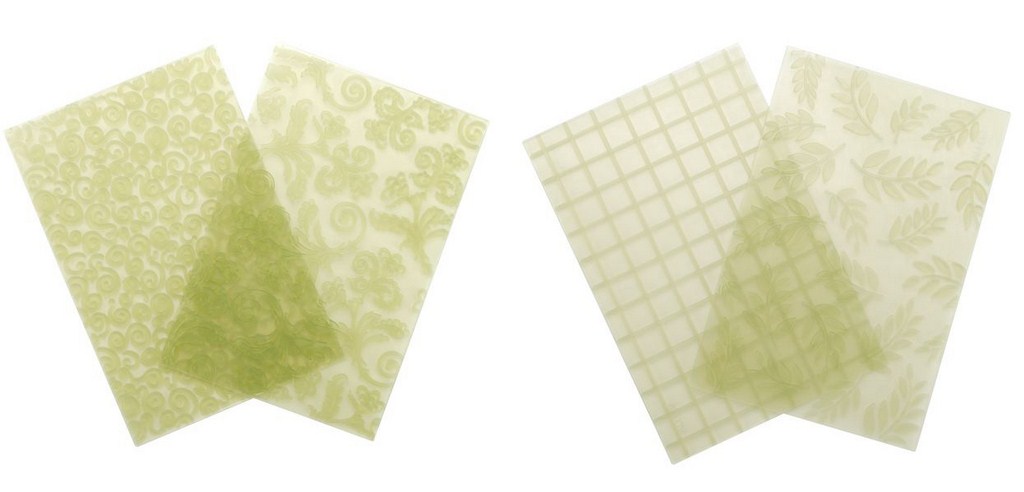
It can be useful as a substrate for baking your products, and with its help it is good to remove fingerprints from clay.

13. Sandpaper
Suit its different types: from large to fine polishing. The first is useful for giving the effect of antiquity, scratches, and the second is needed to improve the presentation, it also helps to remove fingerprints and minor flaws in products. For polishing, nail files and polishing blocks are also suitable. And for polishing a piece of jeans fabric will serve well.


You may need it as a frame or a base for your product. Also from the foil you can make a hill-base for baking, it will easily stick toothpicks with beads.
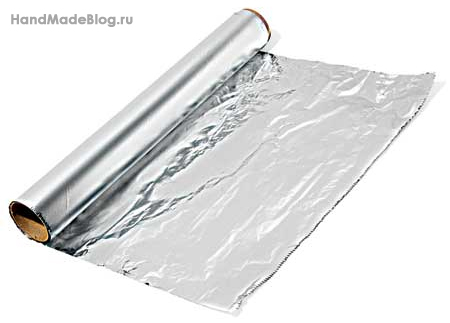
15. Rubber gloves
Some masters prefer to work in gloves, so that the products do not leave fingerprints.
16. Thin food film is well suited for storing plastics and for cutting parts using molds.
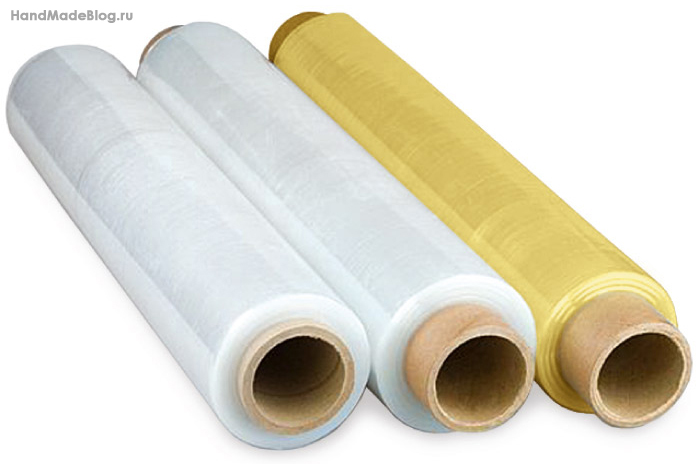
(oven)

If your oven does not work, you can buy a mini oven with convection mode and use it to bake products from polymer clay.
I use a Scarlett SC-099 mini oven.
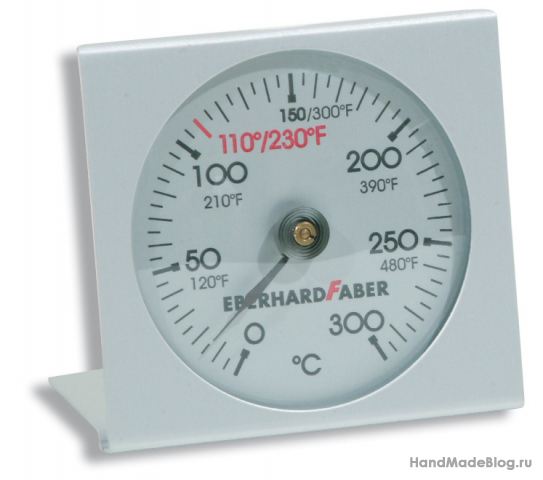
Not all ovens have an accurate temperature control or the sensors show it inaccurately. For such cases, a special "oven" thermometer is useful. It is put directly into the oven and shows the exact temperature in it.
19. Tools for working with wire and for assembling ready-made jewelry.
— Pliers (or thin-nosed) have a flat sponge. They can be flat and grooved. More commonly used for breaking links, rings, as well as for holding small parts.
— Side cutters (nippers) is a cutting tool. They are used for biting wire, string, fishing line.
— Roundogs Used to work with pins and wire. Thanks to them, you can make a ring at the end of the pin.

20. Special lacquer for polymer clay - it will be useful for you to create a protective layer on products made of polymer clay, as well as decorative coating.

21. Brush for varnish.
22. Drills 1, 1.5 and 2 mm - for drilling holes in beads.
23. Wet and plain wipes - for rubbing hands and tools.
Conclusion:
This is the set of tools for working with polymer clay, which should be, in my opinion, every master. These tools for plastic make it easier to create products, and most importantly will help to achieve the desired result. As I already wrote at the very beginning - a set of tools for polymer clay - each master will eventually be replenished with his devices and favorite tricks.
Here the main thing is trying, experimenting and finding yourself loyal "helpers".
P.S. If you liked and used my article, please leave a comment under this entry. Although "+" put, for me it is important to know that the article was useful to you

Perhaps you have already heard about such a popular material for creativity as polymer clay, and even saw souvenirs or jewelry made from it. You want to try it yourself, but do not know where to start? Then our article is for you!
Let's start with the definition.
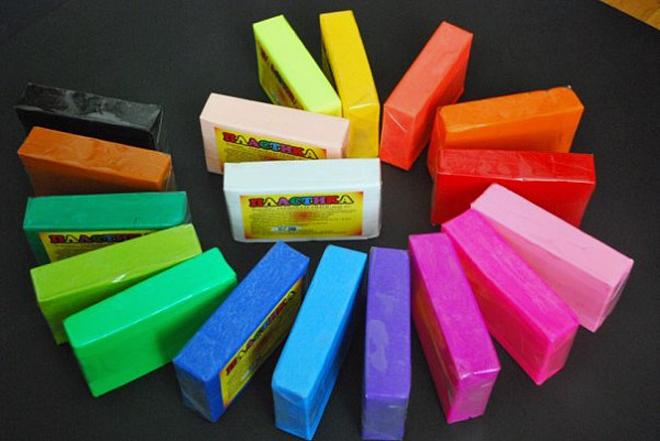
Polymer clay (also, plastic) - a plastic material for modeling (small items, jewelry, sculptures, dolls) and modeling, freezing in air or with heating (depending on the type of plastic). According to the name of the manufacturing companies: fimo, flower, scalp, cernite, cath, etc.

Materials and tools needed to get started:
Several blocks of plastic. White, black and seven primary colors.
More popular are foreign materials - "Fimo", "Cernit" and "Sculpey". The brands differ in the producing country, baking temperature and color palette.
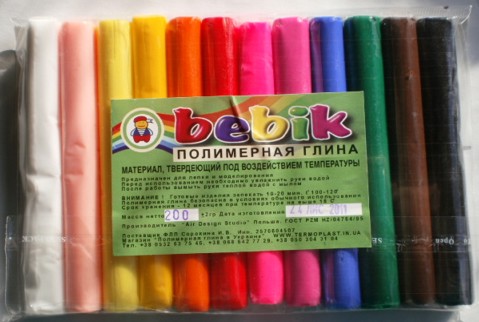
Plastics are very different: for making dolls and for removing forms, luminous in the ultraviolet and dark, matte and translucent, with sparkles and metallic, pearlescent and imitating the structure of the stone, and even rubber and liquid plastics.
The main types of polymer clay and the features of working with it:
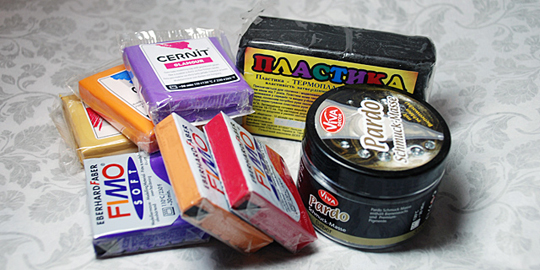
Domestic St. Petersburg plastic "Tsvetik"
the cheapest, and although it is difficult to work with it - it is quite firm and more brand-name, but from it with special skill and patience it is possible to make beautiful pendants and beads.German plastic Cernit (Cernite) on the contrary, someone may seem too soft at work, but the price, quality and range of colors are very attractive.
The most popular now is the brand Fimo, German manufacturer of artistic products Eberhard Faber. Fimo Classic (Fimo Classic) more solid plastic, Fimo Soft (Fimo Soft) - soft, easy to warm up. Polymer clay Fimo is produced in a huge range of colors, there are even with sparkles, transparent (transmitting light) and glowing in the ultraviolet color.
In America, two brands of polymer clay are produced - Kato (Kato PolyClay) and Scalpe (Sculpey). The plastic of the company Kato is not sold in Russian stores, but for those who find it, I will say - be ready for a pretty strong smell of Soviet gouache. Otherwise, this clay is similar to other brands.
Firm Polyform Products (Polyform Products) produces a whole line of polymer clays Scalpey (Super Sculpey) is a polymeric clay for sculptors. There is a gray-olive, very hard, and beige (flesh-colored), soft, for making dolls. Also available is Skalpy terracotta. Sold in large briquettes at 454 grams (pound).
Scalpie-3 (Scupley-III) - a series of very bright, attractive colors. Soft, very comfortable in the work of plastic. Sold as Fimo and other plastics in small packs of 56gr, as well as in children's sets of 6-12 colors per pack.
Skalpy Premo (Premo!) - was designed specifically for artists. With a wide variety of colors, this brand is the most durable after baking from all of the above.
In addition to metal, mother-of-pearl, luminous in the dark and in the ultraviolet colors, similar to other firms, Poliform Products also produces lightweight polymer clay - Sculpey UltraLight . A large white briquette makes it possible to produce very light bases for beads, statuettes and pendants. With it you can make a very massive, but, nevertheless, light jewelry, tinting or cuddling on top of this light white with any colored plastic.
Sculpey Super Flex (Sculpey Super Flex) - flexible, bending after baking plastic. Whichever shape you make of this material, it will look like rubber, bend. Imagine how good it will look and how comfortable it will be, for example, flexible leaves and petals of flowers in your product!
The same firm offers a special plastic for making stamps - Sculpey Mold Maker. Before baking, it is very soft and pliable, easily takes any shape, it can remove an impression from almost any object and surface. After baking it as well as Super Flex flex easily, which is very convenient when working with the technique of stamps. And if you need to repeat some form or relief several times, multiply your favorite decoration, this material is almost indispensable.
Granitex series - It is a plastic with inclusions simulating a pattern of the surface of various stones.
In addition to the firm ("plasticine") plastics firms Fimo, Skalpy and Kato release and liquid plastic - gel. It is a transparent fluid material that also hardens after the temperature treatment, just like hard plastic. The possibilities of working with gel are also limitless.
Working surface:

a piece of glass, plexiglas or even tiles will do. The main thing is that the surface is strong to the impact of the knife and glossy - so that the material does not stick.
Tools for work:

You will need sharp knife - you can also clerical - in order to cut off the pieces of plastic you need. You can buy special sets of knives.
Something smooth and round like a rolling pin, (for example: a test tube) . You can take any smooth bottle or glass.
Wooden toothpicks (on them we will string beads for roasting).
Heat treatment:
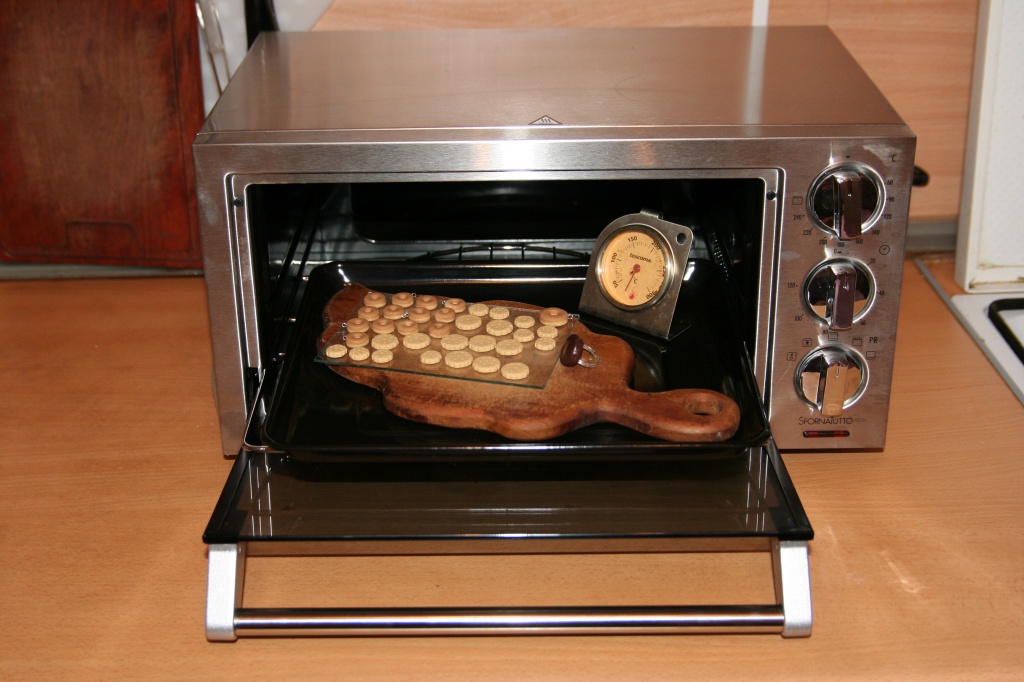
You need a little: an oven and some kind of baking surface. A baking sheet, a wooden board, a plate will do. If you will bake products on a metal surface, it is better to cover it with plain or baking paper to avoid overheating and burning. Note that the dishes on which you will bake your work should not be used later for cooking or eating food.
For further processing of already baked plastic:
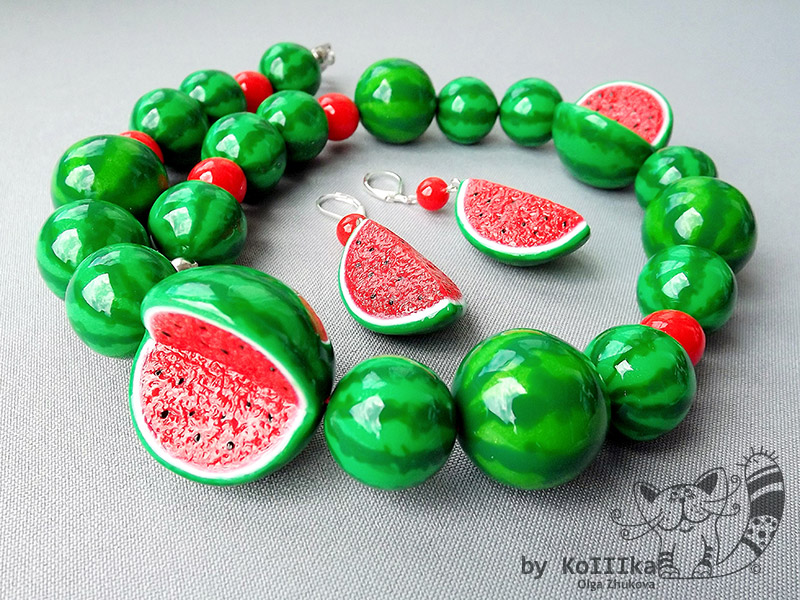
Sandpaper for polishing products: 600, 800, 1000, 1250. You can use a four-sided polisher for nails. You can not polish at all, if you sculpt in smooth gloves and carefully.
Varnish, so that your work retains a pristine appearance, do not get dirty or tarnish. Special lacquers for plastic, for example Fimo and Sculpey, are produced, but you can choose a suitable varnish. Detailed information on this subject can be found on the Internet.
If you are going to be engaged in the manufacture of jewelry, you, of course, will need different accessories - hooks for earrings, chains, locks, special pieces of wire with a loop on the end for various fastenings and much more. All this can be found in the assortment in shops for sewing and creativity, as well as in the above-mentioned online stores.
Working with polymer clay is very simple
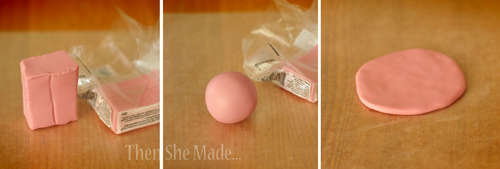
The right size of a piece of plastic must be kneaded well, so that the material becomes soft and plastic.
Important: in plastic should not remain air bubbles - when heated, the air will expand and the product will warp.
Another nuance is that it is necessary to accurately monitor the recommended temperature (it is always indicated on the package) and not to exceed - otherwise the material will begin to burn, releasing toxic substances.
There are a lot of techniques for working with polymer clay, thanks to which you can create unique, original, stylish decor items, accessories and jewelry for you and your loved ones.
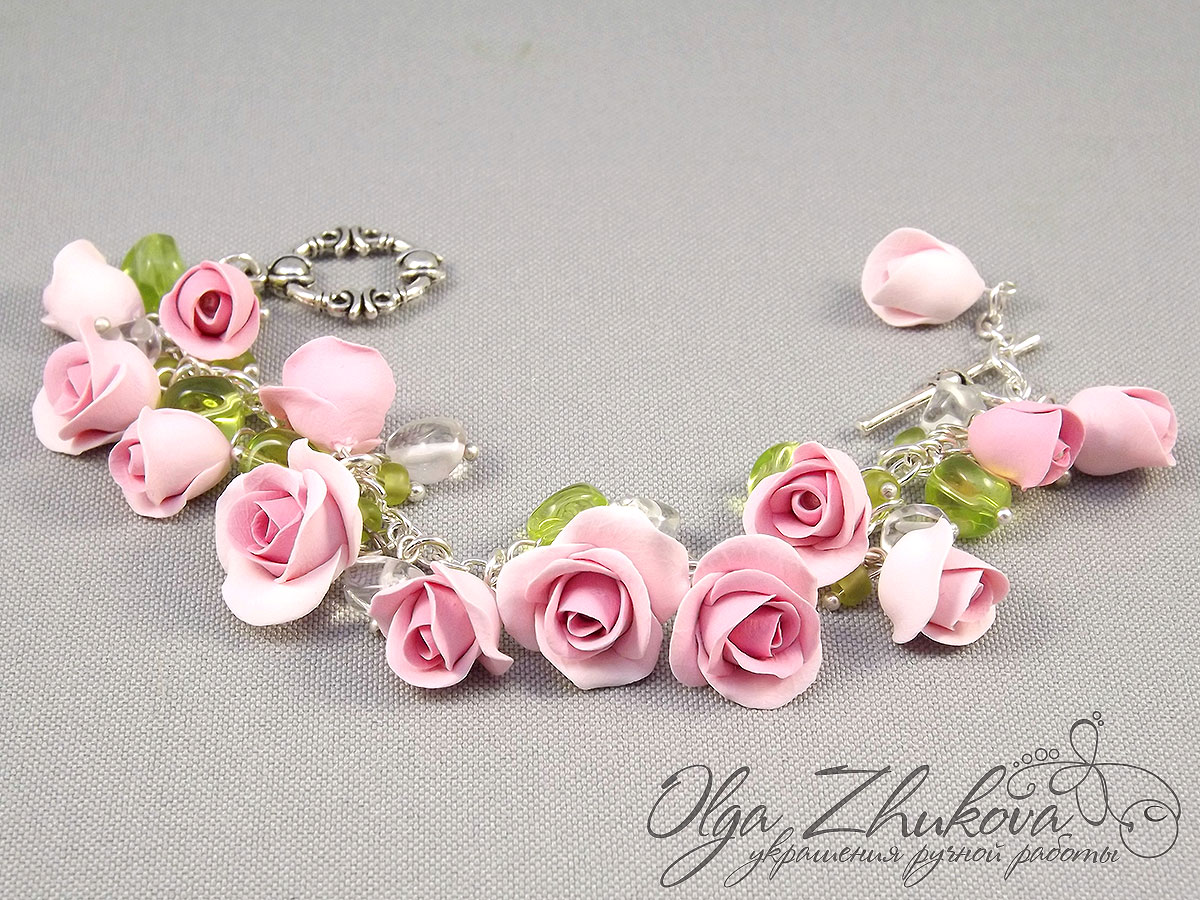
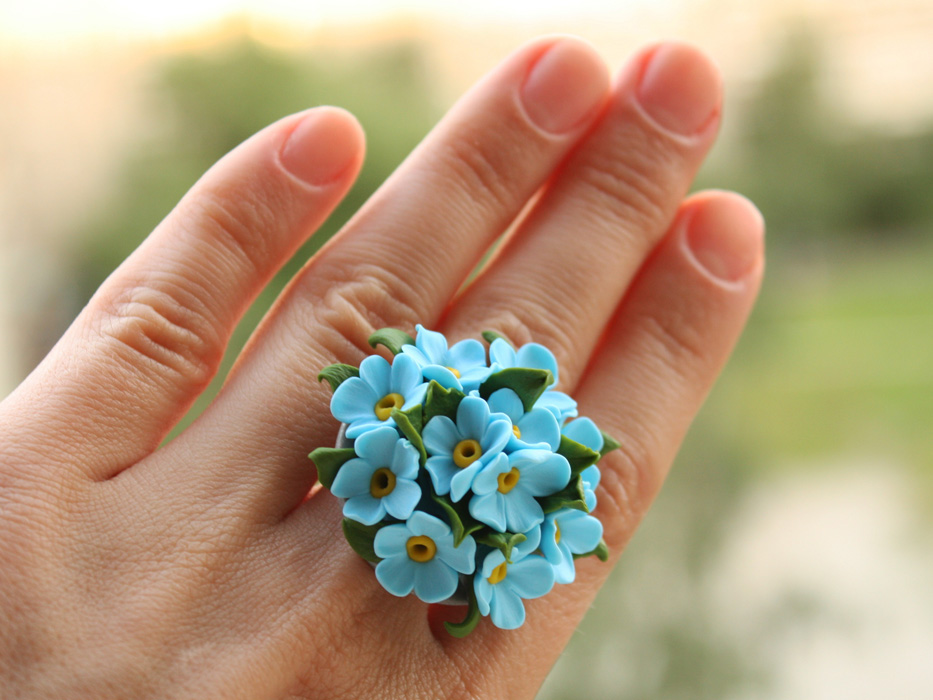


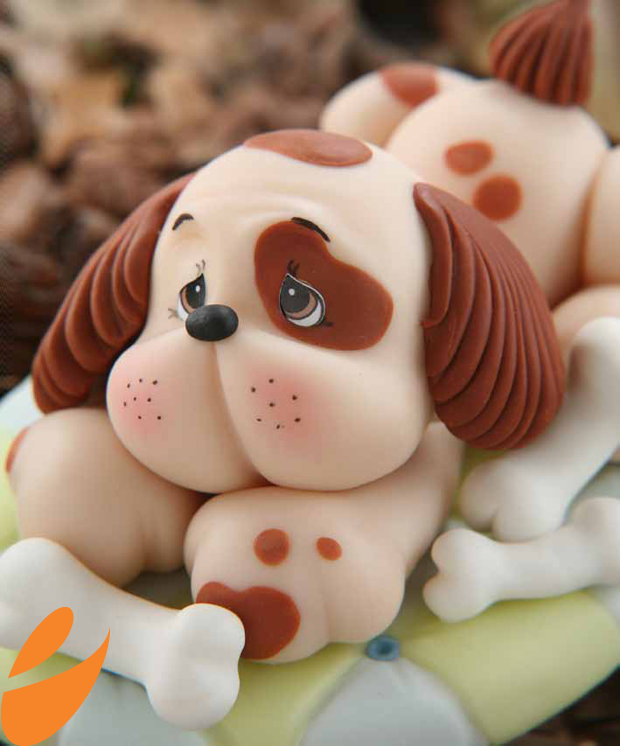
Secrets shared by Lyudmila Kononova
